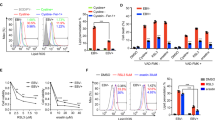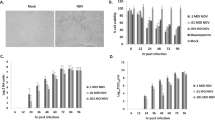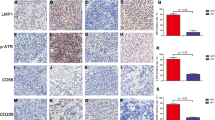Abstract
Nasopharyngeal carcinoma (NPC) is a malignant disease associated with Epstein–Barr virus (EBV) infection. This study aims to examine the effects of EBV infection on the production of proinflammatory cytokines in NPC cells after the Zn-BC-AM photodynamic therapy (PDT) treatment. Cells were treated with the photosensitiser Zn-BC-AM for 24 h before light irradiation. Quantitative ELISA was used to evaluate the production of cytokines. Under the same experimental condition, HK-1-EBV cells produced a higher basal level of IL-1α (1561 pg/ml), IL-1β (16.6 pg/ml) and IL-8 (422.9 pg/ml) than the HK-1 cells. At the light dose of 0.25–0.5 J/cm2, Zn-BC-AM PDT-treated HK-1-EBV cells were found to produce a higher level of IL-1α and IL-1β than the HK-1 cells. The production of IL-1β appeared to be mediated via the IL-1β-converting enzyme (ICE)-independent pathway. In contrast, the production of angiogenic IL-8 was downregulated in both HK-1 and HK-1-EBV cells after Zn-BC-AM PDT. Our results suggest that Zn-BC-AM PDT might indirectly reduce tumour growth through the modulation of cytokine production.
This is a preview of subscription content, access via your institution
Access options
Subscribe to this journal
Receive 12 digital issues and online access to articles
$119.00 per year
only $9.92 per issue
Buy this article
- Purchase on Springer Link
- Instant access to full article PDF
Prices may be subject to local taxes which are calculated during checkout


Similar content being viewed by others
References
Gollnick SO, Evans SS, Baumann H, Owczarczak B, Maier P, Vaughan L et al. Role of cytokines in photodynamic therapy-induced local and systemic inflammation. Br J Cancer 2003; 88: 1772–1779.
Karrer S, Bosserhoff AK, Weiderer P, Landthaler M, Szeimies RM . Keratinocyte-derived cytokines after photodynamic therapy and their paracrine induction of matrix metalloproteinases in fibroblasts. Br J Dermatol 2004; 151: 776–783.
Liu W, Oseroff AR, Baumann H . Photodynamic therapy causes cross-linking of signal transducer and activator of transcription proteins and attenuation of interleukin-6 cytokine responsiveness in epithelial cells. Cancer Res 2004; 64: 6579–6587.
Nseyo UO, Whalen RK, Duncan MR, Berman B, Lundahl SL . Urinary cytokines following photodynamic therapy for bladder cancer. A preliminary report. Urology 1990; 36: 167–171.
Wong TW, Tracy E, Oseroff AR, Baumann H . Photodynamic therapy mediates immediate loss of cellular responsiveness to cytokines and growth factors. Cancer Res 2003; 63: 3812–3818.
Abdel-Hady ES, Martin-Hirsch P, Duggan-Keen M, Stern PL, Moore JV, Corbitt G et al. Immunological and viral factors associated with the response of vulval intraepithelial neoplasia to photodynamic therapy. Cancer Res 2001; 61: 192–196.
Ziegler K, Unanue ER . Identification of a macrophage antigen-processing event required for I-region-restricted antigen presentation to T lymphocytes. J Immunol 1981; 127: 1869–1875.
Busson P, Braham K, Ganem G, Thomas F, Grausz D, Lipinski M et al. Epstein–Barr virus-containing epithelial cells from nasopharyngeal carcinoma produce interleukin 1 alpha. Proc Natl Acad Sci USA 1987; 84: 6262–6266.
Beck A, Pazolt D, Grabenbauer GG, Nicholls JM, Herbst H, Young LS et al. Expression of cytokine and chemokine genes in Epstein–Barr virus-associated nasopharyngeal carcinoma: comparison with Hodgkin’s disease. J Pathol 2001; 194: 145–151.
Lin CT, Kao HJ, Lin JL, Chan WY, Wu HC, Liang ST . Response of nasopharyngeal carcinoma cells to Epstein–Barr virus infection in vitro. Lab Invest 2000; 80: 1149–1160.
Lo AK, Lo KW, Tsao SW, Wong HL, Hui JW, To KF et al. Epstein–Barr virus infection alters cellular signal cascades in human nasopharyngeal epithelial cells. Neoplasia 2006; 8: 173–180.
Hsu M, Wu SY, Chang SS, Su IJ, Tsai CH, Lai SJ et al. Epstein–Barr virus lytic transactivator Zta enhances chemotactic activity through induction of interleukin-8 in nasopharyngeal carcinoma cells. J Virol 2008; 82: 3679–3688.
Huang YT, Sheen TS, Chen CL, Lu J, Chang Y, Chen JY et al. Profile of cytokine expression in nasopharyngeal carcinomas: a distinct expression of interleukin 1 in tumor and CD4+ T cells. Cancer Res 1999; 59: 1599–1605.
Mak NK, Li KM, Leung WN, Wong RN, Huang DP, Lung ML et al. Involvement of both endoplasmic reticulum and mitochondria in photokilling of nasopharyngeal carcinoma cells by the photosensitizer Zn-BC-AM. Biochem Pharmacol 2004; 68: 2387–2396.
Huang DP, Ho JH, Poon YF, Chew EC, Saw D, Lui M et al. Establishment of a cell line (NPC/HK1) from a differentiated squamous carcinoma of the nasopharynx. Int J Cancer 1980; 26: 127–132.
Tocci MJ . Structure and function of interleukin-1 beta converting enzyme. Vitam Horm 1997; 53: 27–63.
Mak NK, Lung ML, Chang CK, Leung KN . Photosensitizers as novel compounds in apoptosis research. In: Corvin AJ (ed.) New Developments in Cell Apoptosis Research. New York: Nova Science Publishers, Inc., 2006; 241–272.
Du H, Bay BH, Mahendran R, Olivo M . Hypericin-mediated photodynamic therapy elicits differential interleukin-6 response in nasopharyngeal cancer. Cancer Lett 2005; 235: 202–208.
Li KM, Sun X, Koon HK, Leung WN, Fung MC, Wong RNS et al. Apoptosis and expression of cytokines triggered by pyropheophorbide-a methyl ester-mediated photodynamic therapy in nasopharyngeal carcinoma cells. Photodiagn Photodyn Ther 2006; 3: 247–258.
Braunschweiger PG, Basrur VS, Santos O, Markoe AM, Houdek PV, Schwade JG . Synergistic antitumor activity of cisplatin and interleukin 1 in sensitive and resistant solid tumors. Cancer Res 1993; 53: 1091–1097.
Kilian PL, Kaffka KL, Biondi DA, Lipman JM, Benjamin WR, Feldman D et al. Antiproliferative effect of interleukin-1 on human ovarian carcinoma cell line (NIH:OVCAR-3). Cancer Res 1991; 51: 1823–1828.
Yoshizaki T, Horikawa T, Qing-Chun R, Wakisaka N, Takeshita H, Sheen TS et al. Induction of interleukin-8 by Epstein–Barr virus latent membrane protein-1 and its correlation to angiogenesis in nasopharyngeal carcinoma. Clin Cancer Res 2001; 7: 1946–1951.
Du H, Bay BH, Mahendran R, Olivo M . Endogenous expression of interleukin-8 and interleukin-10 in nasopharyngeal carcinoma cells and the effect of photodynamic therapy. Int J Mol Med 2002; 10: 73–76.
Acknowledgements
This work was partly supported by the Research Grant Council of Hong Kong (HKBU2052/02M and HKBU2458/06M).
Author information
Authors and Affiliations
Rights and permissions
About this article
Cite this article
Koon, HK., Lo, KW., Leung, KN. et al. Photodynamic therapy-mediated modulation of inflammatory cytokine production by Epstein–Barr virus-infected nasopharyngeal carcinoma cells. Cell Mol Immunol 7, 323–326 (2010). https://doi.org/10.1038/cmi.2010.4
Received:
Revised:
Accepted:
Published:
Issue Date:
DOI: https://doi.org/10.1038/cmi.2010.4



